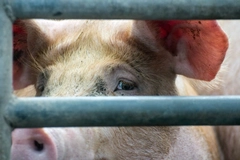
- Industry news
Industry news
- Category news
Category news
- Reports
- Key trends
- Multimedia
- Journal
- Events
- Suppliers
- Home
- Industry news
Industry news
- Category news
Category news
- Reports
- Key trends
- Multimedia
- Events
- Suppliers
Chicken Claims Center Plate in Meat Market Growth

Chicken was also good for 6.3% growth at retail in 2008, despite a dip in beef retail dollar sales and a nose dive for specialty meats. Premium red meats have been on the chopping block.
04/12/08 Consumers have trimmed their consumption of beef, veal and turkey since 1996; while the $66 billion beef sector still rules the roost, chicken was increasingly what's for dinner in 2008. Chicken sales winged up 6.7% in 2008, three times the overall growth rate for retail and foodservice meat, according to The Fresh Meat Market in the U.S.: Beef, Chicken, Pork, Turkey and Lamb in Retail and Foodservice, a new research report just released by Packaged Facts.

Chicken was also good for 6.3% growth at retail in 2008, despite a dip in beef retail dollar sales and a nose dive for specialty meats. Premium red meats have been on the chopping block for recession-battered grocery shoppers looking to cut back.
But chicken isn't just about lower-cost protein, says Tatjana Meerman, the Publisher for Packaged Facts. "The healthfulness of white meat has been hardwired into the American consumer psyche, and now natural and organic claims give chicken a leg up among consumers looking for prime cuts." The Fresh Meat Market in the U.S. estimates that 31% of retail meat was labelled natural in 2008, up seven percentage points from 2007.
Natural and organic claims -- along with free-range or cage-free chicken, grass-fed beef, humanely raised veal, and crate-free pork -- resonate with a consuming public increasingly concerned about food quality, food contamination, and the environmental and ethical implications of their food choices.
Meat branding also helps marketers connect with consumers. The Fresh Meat Market in the U.S. estimates that 50% of retail meat was supplier branded in 2008, up 4% from 2007. Telling a story about meat through branding helps re-establish confidence in consumers, who are more likely to pay a premium for meat when they can not only savor the taste but trust in the quality.
Special livestock, minimal ingredient addition, cut variations and case-ready packaging round out the strategies for raw meat to be a cut above, according to the report. Special livestock has helped make red meat hot for foodservice splurges, whether it's Angus burgers at casual chains, Kobe/Wagyu beef in upscale restaurants, or grass-fed Estancia beef from Uruguay in trendy San Francisco eateries. Tapping into trends is essential because the value-consciousness of retail meat shoppers during 2008 should continue well into 2010.
The Fresh Meat Market in the U.S. provides a one-stop analysis of market dynamics for raw, minimally processed meat and poultry sold through retail and foodservice sectors. The report provides market size and growth data for 2004-2008 and projections through 2013; retail vs. foodservice trend comparisons; global market perspective, including import and export data; a Top 10 raw meat marketer compilation for 2008 and competitive profiles of major marketers; retail channel shares analysis, including self-serve vs. full-service/butcher breakouts and retail preferences among organic shoppers; and per capita consumption and demographic data by product type.










